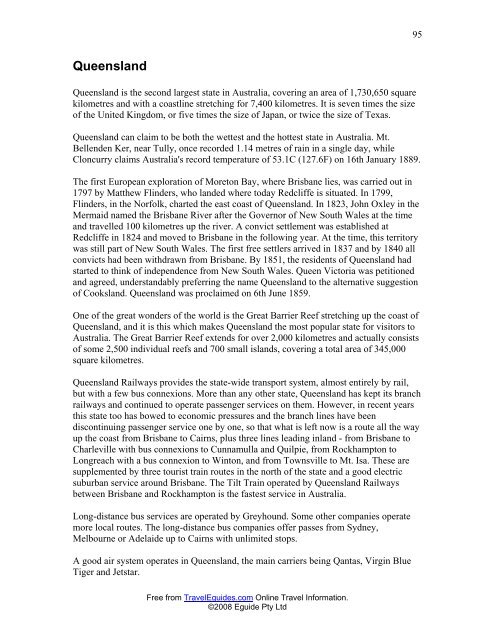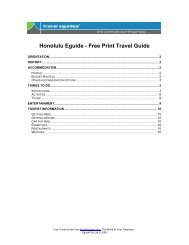Australia Eguide - Travel Guides
Australia Eguide - Travel Guides
Australia Eguide - Travel Guides
You also want an ePaper? Increase the reach of your titles
YUMPU automatically turns print PDFs into web optimized ePapers that Google loves.
95<br />
Queensland<br />
Queensland is the second largest state in <strong>Australia</strong>, covering an area of 1,730,650 square<br />
kilometres and with a coastline stretching for 7,400 kilometres. It is seven times the size<br />
of the United Kingdom, or five times the size of Japan, or twice the size of Texas.<br />
Queensland can claim to be both the wettest and the hottest state in <strong>Australia</strong>. Mt.<br />
Bellenden Ker, near Tully, once recorded 1.14 metres of rain in a single day, while<br />
Cloncurry claims <strong>Australia</strong>'s record temperature of 53.1C (127.6F) on 16th January 1889.<br />
The first European exploration of Moreton Bay, where Brisbane lies, was carried out in<br />
1797 by Matthew Flinders, who landed where today Redcliffe is situated. In 1799,<br />
Flinders, in the Norfolk, charted the east coast of Queensland. In 1823, John Oxley in the<br />
Mermaid named the Brisbane River after the Governor of New South Wales at the time<br />
and travelled 100 kilometres up the river. A convict settlement was established at<br />
Redcliffe in 1824 and moved to Brisbane in the following year. At the time, this territory<br />
was still part of New South Wales. The first free settlers arrived in 1837 and by 1840 all<br />
convicts had been withdrawn from Brisbane. By 1851, the residents of Queensland had<br />
started to think of independence from New South Wales. Queen Victoria was petitioned<br />
and agreed, understandably preferring the name Queensland to the alternative suggestion<br />
of Cooksland. Queensland was proclaimed on 6th June 1859.<br />
One of the great wonders of the world is the Great Barrier Reef stretching up the coast of<br />
Queensland, and it is this which makes Queensland the most popular state for visitors to<br />
<strong>Australia</strong>. The Great Barrier Reef extends for over 2,000 kilometres and actually consists<br />
of some 2,500 individual reefs and 700 small islands, covering a total area of 345,000<br />
square kilometres.<br />
Queensland Railways provides the state-wide transport system, almost entirely by rail,<br />
but with a few bus connexions. More than any other state, Queensland has kept its branch<br />
railways and continued to operate passenger services on them. However, in recent years<br />
this state too has bowed to economic pressures and the branch lines have been<br />
discontinuing passenger service one by one, so that what is left now is a route all the way<br />
up the coast from Brisbane to Cairns, plus three lines leading inland - from Brisbane to<br />
Charleville with bus connexions to Cunnamulla and Quilpie, from Rockhampton to<br />
Longreach with a bus connexion to Winton, and from Townsville to Mt. Isa. These are<br />
supplemented by three tourist train routes in the north of the state and a good electric<br />
suburban service around Brisbane. The Tilt Train operated by Queensland Railways<br />
between Brisbane and Rockhampton is the fastest service in <strong>Australia</strong>.<br />
Long-distance bus services are operated by Greyhound. Some other companies operate<br />
more local routes. The long-distance bus companies offer passes from Sydney,<br />
Melbourne or Adelaide up to Cairns with unlimited stops.<br />
A good air system operates in Queensland, the main carriers being Qantas, Virgin Blue<br />
Tiger and Jetstar.<br />
Free from <strong>Travel</strong><strong>Eguide</strong>s.com Online <strong>Travel</strong> Information.<br />
©2008 <strong>Eguide</strong> Pty Ltd




